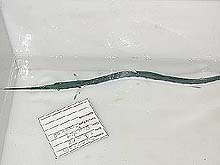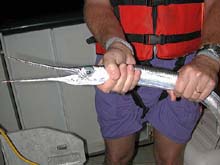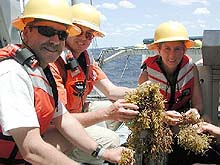
Alan Felker, North Carolina Educator at Sea (far left) sorts through sargassum collected during a neuston net tow. The science team separates fish and invertebrates, counts them and determines what species they are. Click image for a larger view.
Perspective from a North Carolina Educator
August 10, 2002
Alan Felker, North Carolina Educator at Sea Hardin Park School
NC Museum of Natural Sciences
As the North Carolina Educator at Sea, I have a special purpose on this mission. Working through the North Carolina Museum of Natural Sciences, my role here is to convey my thoughts and pass on acquired knowledge to teachers and students throughout my state and across the nation. Having never been out to sea, every day presents new adventures in natural history.
Scientists from throughout the United States are onboard the ship. Each of these people has a great deal of passion for his and her particular fields of study. More importantly, these scientists are more than willing to explain the studies and collection techniques used on this expedition. Being surrounded by these types of individuals makes learning almost infectious.
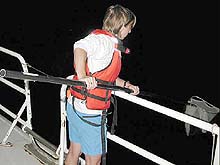
Using a technique called “night-lighting” scientists hang bright lights over the side of the ship to attract fish and invertebrates in the area. Here one of the science team stands by to collect any organisms that she sees with a dipnet. Click image for a larger view.
Many students often think of scientists as older men in white lab coats locked away in a laboratory and peering though microscopes. The images that educators and the media often present to students help to affirm this notion. However, being at sea with scientists on this mission quickly sets aside this preconceived notion. Half of the scientists on board are female, and having spent several days on board the R/V Seward Johnson, I have seen no white lab coats.
Scientists on board this ship have the same feelings as anyone else. They get excited when there is a good catch and they show disappointment when the weather prevents them from sampling. Everyone appears to be quite patient when waiting for the weather to clear and the currents to calm. It is not worth risking human life just to collect some data.
When the submersible unit comes up from a dive, everyone is ready to assist in the preparation and preservation of the materials acquired on the dive. Each dive potentially may produce specimens previously unseen by humans. The variety of life that the seas hold is almost immeasurable. The submersible dives also hold potential risk to those on board, but every possible risk factor is reduced to an absolute minimum.
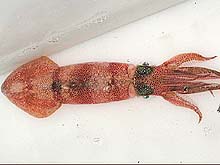
This Arrow squid measured almost two feet long when it was brought aboard the Seward Johnson. Click image for a larger view.
Heading towards land helped to provide us some shelter from high seas, which had been kicked up by tropical storm Cristobal. Calmer coastal waters allowed for some “night-lighting” spotlighting and scoop netting. As the sea animals approach the lights, we are able to capture them with long-handled nets. Several hours of this procedure accounted for catches of numerous needlefish, crabs, squid, shark, and sightings of juvenile sailfish.
Being on board a research vessel has increased my personal knowledge of oceanographic hardware. The neuston net samples surface waters and often gathers large amounts of sargassum. Unfortunately, many of the samples from the neuston net also produce small amounts of trash, including plastics, balloons, shoes and shipping pallets. The sightings of trash in our open oceans reinforce the concept of being responsible citizens with our waste materials.
This expedition allows students in schools to participate in ongoing scientific research. Schools may also post questions for our scientists, which allows students to interact with current scientific endeavors on a real-time basis. Through activities such as this expedition, we hope that students will see the large variety of occupations that the scientific community offers. Also, if we are able to show how and why it is necessary to study the natural world, then perhaps we can increase the level of scientific literacy in our target audience and spark the imagination of young minds.
Sign up for the Ocean Explorer E-mail Update List.















































